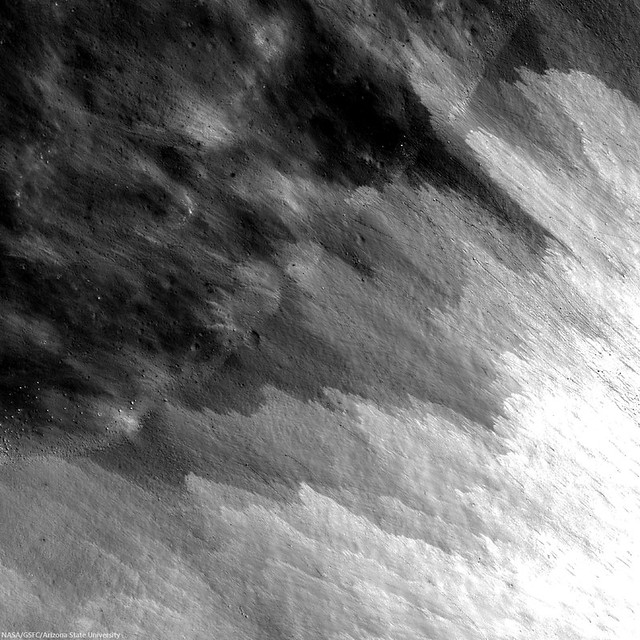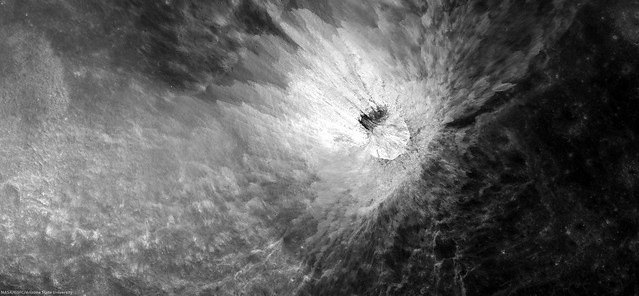 |
| Ejecta from a fresh crater impacted upon southeastern wall of Darwin C, field of view roughly 3 km. LROC NAC mosaic M1119341350LR, LRO orbit 16162, March 31, 2013; resolution 78 cm per pixel, angle of incidence 29.72° from 78.73 km [NASA/GSFC/Arizona State University]. |
Raquel Nuno
LROC News System
Today's Featured Image shows a small portion of the ejecta blanket of an unnamed fresh impact crater (1 km diameter) located on the southeastern wall of crater Darwin C (15 km diameter, over 2500 meters deep).
LROC News System
Today's Featured Image shows a small portion of the ejecta blanket of an unnamed fresh impact crater (1 km diameter) located on the southeastern wall of crater Darwin C (15 km diameter, over 2500 meters deep).
The linear reflectance boundary that runs diagonally from lower left to upper right is a break in slope between the steep wall (lower right) and floor (upper left) of Darwin C crater; to the left of that line the floor is essentially flat.
Exposure to space weathering tends to lower the albedo of surface materials on an airless body like the Moon. But compositional differences also affect the reflectance of surface materials. So how can we tell whether the ejecta deposits in today's Featured Image have higher reflectance due to freshness or composition? It helps to look at the parent crater from where the ejecta was delivered. If we look at the context image below, we can see that it is very blocky. This is another clue that the crater is young; the blocks have not been worn down by micrometeorite bombardment. Also, with time, gravity and other disturbances, such as ground shaking from other impacts, pull material down the walls of a crater. But we see that the crater walls are crisp; they have not begun to slump even though this crater formed on an incline. All of these clues let us confidently assume that this is a fresh (young) crater that has not been exposed to the space environment or gravity for very long.
The fresh crater is centered at 20.09°S, 70.67°W and is approximately 1 km in diameter, about the size of Meteor crater, Arizona. Darwin C is located at immediately southeast and is approximately 16 km in diameter.
Check out today's Featured Image at full resolution HERE, and explore the whole region using LROC's QuickMAP.
Related Posts:
Debris flow down the wall of Dugan J (November 13, 2013)
Bright and Dark Ejecta (September 10, 2013)
Exposure to space weathering tends to lower the albedo of surface materials on an airless body like the Moon. But compositional differences also affect the reflectance of surface materials. So how can we tell whether the ejecta deposits in today's Featured Image have higher reflectance due to freshness or composition? It helps to look at the parent crater from where the ejecta was delivered. If we look at the context image below, we can see that it is very blocky. This is another clue that the crater is young; the blocks have not been worn down by micrometeorite bombardment. Also, with time, gravity and other disturbances, such as ground shaking from other impacts, pull material down the walls of a crater. But we see that the crater walls are crisp; they have not begun to slump even though this crater formed on an incline. All of these clues let us confidently assume that this is a fresh (young) crater that has not been exposed to the space environment or gravity for very long.
 |
| LROC NAC double-observation mosaic (M1119341350LR with M1116983132LR) of impact crater located on the wall of crater Darwin C. The floor of Darwin C is the darker circular area to the left of the linear reflectance boundary. Image field of view roughly 13 km [NASA/GSFC/Arizona State University]. |
Check out today's Featured Image at full resolution HERE, and explore the whole region using LROC's QuickMAP.
Related Posts:
Debris flow down the wall of Dugan J (November 13, 2013)
Bright and Dark Ejecta (September 10, 2013)
Ejecta interference patterns (February 21, 2013)
Brush strokes on a lunar canvas (May 30, 2012)
Swept Surface inside Nicholson crater (December 29, 2012)
Slumping rim of Darwin C (April 29, 2011)
Ejecta sweeps the surface (October 11, 2009)


No comments:
Post a Comment